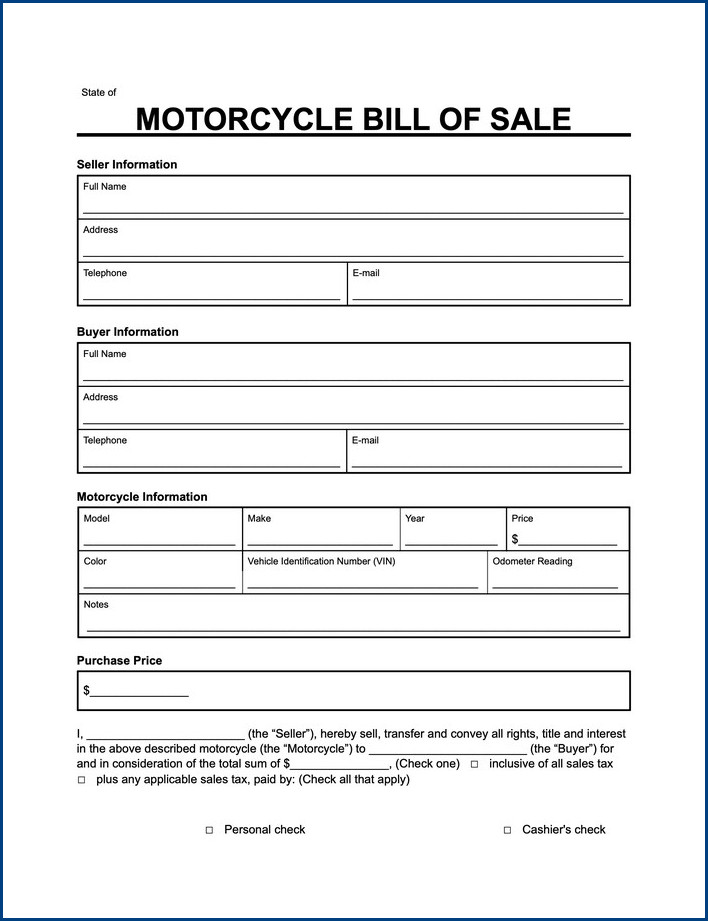
How do you sell a motorcycle?
Selling a motorcycle can be a smooth process if you follow a few key steps.
- Make sure you have all the necessary paperwork ready, including the bill of sale. This document serves as proof of the transaction and includes details such as the buyer and seller’s information, the motorcycle’s description, and the agreed-upon price.
- Including a bill of sale not only protects you as the seller but also provides peace of mind to the buyer.
- Ensure that your motorcycle is in good condition before putting it on the market. Clean it thoroughly, check for any mechanical issues, and consider getting it serviced to increase its appeal to potential buyers.
What is a motorcycle bill of sale?
A motorcycle bill of sale is a legal document that serves as proof of the transfer of ownership of a motorcycle from one party to another. It outlines the details of the transaction, including the buyer and seller’s names, contact information, and signatures. This document is crucial for both parties involved in the sale as it protects their interests and provides a record of the transaction.
The purpose of a motorcycle bill of sale is to ensure a smooth and transparent transfer of ownership. It protects the buyer by providing proof of purchase, which can be used to register the motorcycle in their name and obtain insurance coverage. Additionally, it protects the seller by releasing them from any liability or responsibility associated with the motorcycle after the sale is complete.
The bill of sale also serves as a safeguard against any potential disputes or disagreements that may arise in the future, as it clearly states the terms and conditions of the sale. Therefore, having a motorcycle bill of sale is essential for both buyers and sellers to ensure a secure and legally binding transaction.




Why is motorcycle bill of sale important?
A motorcycle bill of sale is a crucial document that serves as proof of ownership and transfer of a motorcycle from the seller to the buyer. It is important to have a motorcycle bill of sale for several reasons:
- Legal protection: A bill of sale provides legal protection to both the buyer and the seller. It clearly outlines the terms and conditions of the sale, including the purchase price, date of sale, and any warranties or guarantees. This helps to avoid any disputes or misunderstandings in the future.
- Proof of ownership: A bill of sale acts as a legal document that establishes the ownership of the motorcycle. It provides evidence that the seller has transferred the ownership rights to the buyer. This becomes crucial in case of any legal issues or disputes regarding the ownership of the motorcycle.
- Record of transaction: Keeping a motorcycle bill of sale helps in maintaining a record of the transaction. It includes important details such as the names and contact information of the buyer and seller, vehicle identification number (VIN), and other relevant information. This record can be useful for future reference or for any legal requirements.
Do you need a notarized motorcycle Bill of sale?
The answer to this question depends on the regulations in your specific state or country. In some jurisdictions, a notarized bill of sale is required to legally transfer ownership of a motorcycle. This document provides proof of the transaction and protects both the buyer and the seller. It includes important details such as the names and addresses of the parties involved, the date of sale, the purchase price, and a description of the motorcycle.
To ensure a smooth transfer of ownership and to avoid any legal complications, it is advisable to consult your local motor vehicle department or a legal professional to determine whether a notarized motorcycle bill of sale is necessary in your area.
What to include in a motorcycle bill of sale?
Here are some essential items to include in a motorcycle bill of sale:
- Identification of the parties involved: The bill of sale should clearly state the names, addresses, and contact information of both the buyer and the seller. This helps establish the identities of the individuals involved in the transaction.
- Description of the motorcycle: Provide a detailed description of the motorcycle being sold, including the make, model, year, vehicle identification number (VIN), and any other relevant details. This information helps to clearly identify the specific motorcycle being transferred.
- Purchase price and payment terms: Clearly state the agreed-upon purchase price for the motorcycle. Additionally, specify the payment terms, such as whether it will be paid in full upfront or in installments, and include the due date(s) for any remaining payments.
- Date and location of the sale: Include the date and location where the sale is taking place. This helps establish the jurisdiction under which the transaction is taking place and can be useful for record-keeping purposes.
- Signatures and notarization: Both the buyer and the seller should sign the bill of sale to indicate their agreement to the terms. Notarization can add an extra layer of authenticity and can be beneficial if legal issues arise in the future.
By including these key elements in a motorcycle bill of sale, both the buyer and the seller can have peace of mind knowing that the transaction is clearly documented and legally binding. It is important to keep a copy of the bill of sale for future reference and to provide a record of the sale.
Motorcycle Bill Of Sale Template | Word – Download